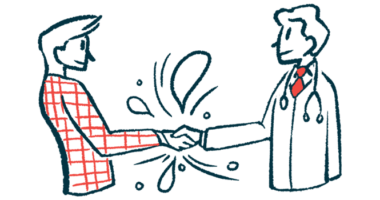Who Is Protecting Whom?

Lately, I’ve been pondering the many ways our lives have changed for the sake of safety, like tamper-proof packaging, airport screening, and two-step password verification. I get it. Identity thieves are everywhere, so are scammers, along with the just plain crazies. We might be a little safer, but I wonder if anyone is keeping track of how the changes affect those of us living with serious chronic conditions like amyotrophic lateral sclerosis (ALS).
The first time I became aware of a forced cultural-consumer change “for our protection” was in the aftermath of the Tylenol murders of 1982. Several bottles of Tylenol capsules had been laced with cyanide, causing a few deaths and nationwide panic.
The resulting packaging protections soon became the industry standard for all over-the-counter medications. I’m sure you’ll agree, it’s now nearly impossible to open a vacuum-sealed bubble pack of cold-relief capsules.
Who hasn’t had the experience?
I swear those flat packs of capsules are tamper-proof, terrorist-proof, and customer-proof. My ALS-weakened fingers cannot begin to grasp the itty-bitty pull-tabs that seem to be merely a package decoration.
Even the cheap eyebrow pencil I buy at Le Walmart comes hermetically sealed in plastic wrap. Only a sharp pair of manicure scissors and my husband’s nimble carving skills can release the pencil from its bonds.
But sometimes the barricade isn’t plastic and aluminum. It can also be invisible, human-made, and enabled by policy and procedure. Again, I get it. But somewhere along the way, we forgot who is protecting whom.
Recently, this happened
It all began a few weeks ago when my husband went to our local pharmacy to pick up my new (for this year) prescription of riluzole, marketed in the U.S. as Rilutek. The pharmacist handed it and the receipt to my husband, and he had instant sticker shock. The bill showed my one-month supply of pills almost cost the same as a sports car. Well, maybe a tiny sports car, but nevertheless, the numbers signaled something was terribly wrong.
This led to a runaround that didn’t do much to protect me.
The pharmacist shrugged her shoulders and suggested we call my health insurance to find out why.
My ALS-affected voice prevents me from speaking fast enough to answer questions over the phone, so my husband does the talking for me. We dialed and were told we had a nine-minute wait. So we waited. The first human voice we heard began with a series of questions. I call it the “20-questions game.”
Beyond the basic name, address, phone, birth date, and account number, we had to share what county we live in, email address, and more. After another brief wait, we were transferred to a customer service representative who asked all the same questions again. Finally, she asked, “How can I help you today?” After explaining the problem and another lengthy wait while she checked her computer, we were told to call Medicare.
The day went downhill from there. Medicare told us to call my doctor. My doctor’s nurse said to call the pharmacy. The pharmacy said, “Nope, not us.”
All along, we played the “20-questions game” multiple times, listened to scratchy on-hold music, and spoke with customer service people who we rightly guessed were working out of their homes. It took two weeks to resolve the issue.
But at what cost? All along, my husband and I kept asking ourselves, who is the customer here? I wondered, what if I were really ill? Or what if I didn’t have someone like my husband to speak on my behalf over the phone? How would I manage it all? Healthcare organizations are certainly protecting their patient’s private information, but for many patients, navigating the path is very difficult.
What’s the moral of my story? There’s no moral, only that we have to live with the changes and challenges. And I know that no matter the challenge, I can live well while living with ALS.
Note: ALS News Today is strictly a news and information website about the disease. It does not provide medical advice, diagnosis, or treatment. This content is not intended to be a substitute for professional medical advice, diagnosis, or treatment. Always seek the advice of your physician or other qualified health provider with any questions you may have regarding a medical condition. Never disregard professional medical advice or delay in seeking it because of something you have read on this website. The opinions expressed in this column are not those of ALS News Today or its parent company, Bionews, and are intended to spark discussion about issues pertaining to ALS.








Kelley Gilbert
Thank you for this article... I'm newly diagnosed with ALS, last December at the age of 55. My left hand and arm are becoming quickly "decorative", and my once chatty voice is now just a whisper. We like you, have decided to face this disease with strength to fight, but a sense of humor in everything that comes our way. But things that shouldn't be a struggle are, we ran into a similar issue with our first prescription of Nuedexta, with insurance requiring my Neurologist to provide medical necessity.(if he prescribed it isn't it necessary?).. after 6 weeks and purchasing the first month ourselves (for $1500) if was approved retroactively. Why doesn't the pharmacy that issues the "ALS only" meds offer to use non-child proof caps, why can't I communicate online with my primary care, orthopeadist or PT/OT teams like I do my ALS Team? Why add one more thing for my husband's already overflowing plate? One more thing for me to make sure he worked into his day. Perhaps it's in an attempt to help us maintain our patience and sense of humor?
Thanks for your spirit... I'm hoping to join that "10+ club" of people living well with ALS.
Kelley
Dagmar Munn
Kelley, thank you so much for sharing your own experiences with the health care system, proving that we are not alone in our frustrations! It sounds like you are well on your way to learning how to live well (and have a laugh or two) while living with ALS. Best wishes to you and your husband. Dagmar
Robert Daniels
Thank you writing about life and lifting the spirits of those with ALS.
Barb Spinniken
I can relate ! As I have lost a lot of strength in my hands and packaging is the worst! Dealing with anything on the phone is stressful and my husband has helped a lot. I do see humor in certain situations but once I start laughing I can't stop very well (that happened in a restaurant with crying and that was embarrassing!) However I seem laugh more than cry ,anyhow thanks for your article it helps to know others are experiencing the same issues.
Kathy Holsinger
Thank you. Misery must love company as you helped me relax from an unbelievably frustrating day. Bill was referred by ALS clinic to do another LFT. The last one done we found out they did not do all the test, specifically the supine LFT. This time I verified the orders and specifically asked the scheduling lady do they have the ability to do all the tests ordered. I was assured they could. Today with the test scheduled for Friday I called and finally got through to the lady who actually does the to verify that when they payed him down to do the supine test that they would have a ventilator to use when he started going out on them. That’s when I was told “oh we can’t do that test here”. So then the calls started to the bigger facility 2 hours from home. 20 calls and I still haven’t spoken to a human being. All this while trying to do my job and handle my office. Tomorrow I’ll call the ALS clinic to see if we can do the partial test and follow up in a couple of weeks with the supine. will Medicare cover it. Then today Bill got a call and was told the cough assist and suction machine were going to be patient pay as Medicare denied . It’s hard enough navigating the maze of the dysfunctional medical system but to continually have to fight to get Bill what he needs has become a full time job. Thank you for letting me vent